Today, EFSP starts two months of posts with European postcards with pictures of Hollywood film stars and/or films. Thursday is the day for the film specials, and our first film is special!
My Fair Lady (George Cukor, 1964) is one of the all-time great film musicals, featuring classic songs by Alan Jay Lerner and Frederick Loewe and the wonderful costumes by Cecil Beaton. The film won eight Oscars, including Best Picture, Best Director and Best Actor for Rex Harrison in his legendary performance as misanthropic phonetics professor Henry Higgins. But Audrey Hepburn failed to be nominated for Best Actress. The Oscar was won by Julie Andrews for Mary Poppins, in what many observers saw as a backlash against Andrews' not being cast in the film after originating the role of Eliza on stage.
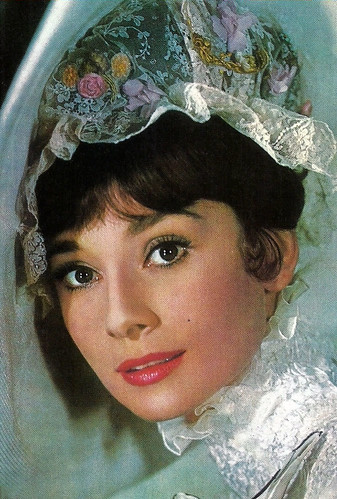
Spanish postcard by Oscarcolor. Photo: Audrey Hepburn in My Fair Lady (George Cukor, 1964).
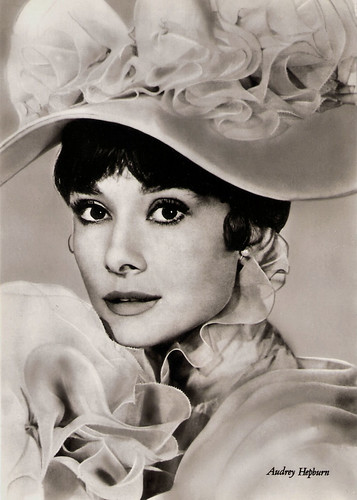
East-German postcard by VEB-Progress Film-Vertrieb, Berlin, no. 2988. Retail price: 0,20 MDM. Photo: Warner Bros. Publicity still for My Fair Lady (George Cukor, 1964). Costume: Cecil Beaton.
My Fair Lady was adapted by Alan Jay Lerner and Frederick Loewe as a stage musical from the the 1913 brilliant stage play Pygmalion by George Bernard Shaw about the delusive dream of a man forming his own perfect woman.
In Edwardian London, Professor Henry Higgins, a scholar of phonetics, believes that the accent and tone of one's voice determines a person's prospects in society. Outside Covent Garden on a rainy evening in 1912, he boasts to a new acquaintance, Colonel Hugh Pickering, himself an expert in phonetics, that he could teach any person to speak in a way that he could pass them off as a duke or duchess at an embassy ball.
Higgins selects as an example a young flower girl, Eliza Doolittle, who has a strong Cockney accent. Higgins tells Pickering that, within six months, he could transform Eliza into a proper lady, simply by teaching her proper English.
Eliza's ambition is to work in a flower shop, but her thick accent makes her unsuitable. Having come from India to meet Higgins, Pickering is invited to stay with the professor. The following morning, face and hands freshly scrubbed, Eliza shows up at Higgins' home, offering to pay him to teach her to be a lady. Pickering is intrigued and offers to cover all expenses, should the experiment be successful.
My Fair Lady became the longest-running Broadway musical with in the leads Rex Harrison as Henry and Julie Andrews as Eliza. With the same cast, the musical also became a huge success in London. Alan Jay Lerner and Frederick Loewe made a great musical score. Most of their songs would become standards over the years that delighted audiences all over the world.
However, when Hollywood producer Jack Warner decided to make a film version of the hit musical, he felt that Andrews, at the time unknown beyond Broadway, wasn't bankable. He replaced her with Audrey Hepburn, a wonderful film actress but not a real singer. Hepburn's singing was dubbed by Marni Nixon, who had dubbed Natalie Wood in West Side Story (1961). Supporting roles went to Stanley Holloway (as Eliza's father, dustman Afred P. Doolittle), Gladys Cooper (Henry's mother Mrs. Higgins), Wilfrid Hyde-White (Colonel Pickering) and Jeremy Brett as the young playboy Freddy.
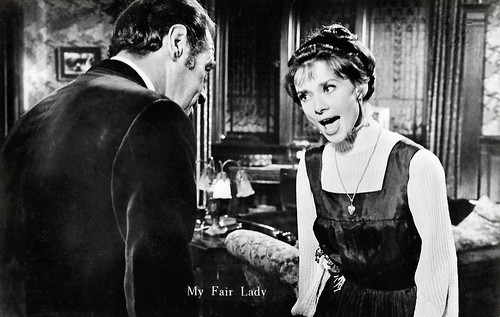
Dutch postcard by Int. Filmpers, Amsterdam, no. 1306. Photo: Warner Bros. Rex Harrison and Audrey Hepburn in My Fair Lady (George Cukor, 1964).
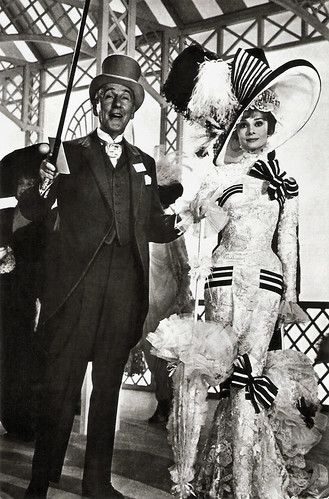
Romanian postcard by Casa Filmului Acin, no. 261. Wilfrid Hyde-White and Audrey Hepburn in My Fair Lady (George Cukor, 1964).
With a production budget of $17 million, My Fair Lady became the most expensive film shot in the United States up to that time. George Cukor created an elegant, colourful adaptation of the beloved stage musical and Rex Harrison did another winning performance. But how did Audrey Hepburn? The move to choose her over Julie Andrews had puzzled many in the theatrical world. How could Eliza be played by anyone else than Andrews?
Hepburn played the unschooled street urchin with a sweet, naive charm. Eliza goes through many forms of speech training, such as speaking with marbles in her mouth, enduring Higgins' harsh approach to teaching and his treatment of her personally. She makes little progress, but just as she, Higgins, and Pickering are about to give up, Eliza finally 'gets it'; she instantly begins to speak with an impeccable upper class accent. As the elegant and beautiful lady at the end of the film, Hepburn literally glows in the exquisite costumes designed for her by Cecil Beaton. She is a perfect match to Harrison's Higgins.
Ephraim Gadsby at IMDb: "The old furors over Audrey Hepburn seem silly in hindsight. Hepburn replaced Julie Andrews, a wonderful singer-actress who had created the role, not only on Broadway but in London. But Andrews was not a familiar face to movie-goers and no one knew if she'd hold an audience in the movies as in the live theaters. Too, Hepburn was an inspired choice, since her background probably would make Eliza Doolittle's transformation from flower-selling gutter-snipe into a lady of quality more believable (Hepburn's mother was a baroness)."
Richard Gilliam in his review at AllMovie: "Exquisitely produced by Warner Bros, it represents the zenith of the movie musical as an art form and as popular entertainment. Rex Harrison leads an impeccable cast, and, yes, that's Marni Nixon singing for Audrey Hepburn, but Hepburn is perfectly cast otherwise. The major star of the film is perhaps set designer/costume designer Cecil Beaton, whose visual contributions immediately impacted European and U.S. fashion trends."
In 1998, the American Film Institute named My Fair Lady (1964) the 91st greatest American film of all time. Critic Roger Ebert put the film on his 'Great Movies' list: "My Fair Lady is the best and most unlikely of musicals, during which I cannot decide if I am happier when the characters are talking or when they are singing. The songs are literate and beloved; some romantic, some comic, some nonsense, some surprisingly philosophical, every single one wonderful."
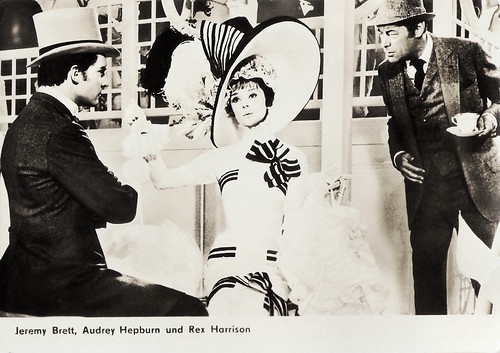
East-German postcard by VEB-Progress Film-Vertrieb, Berlin, no. 2989. Retail price: 0,20 MDM. Photo: Warner Bros. Publicity still for My Fair Lady (George Cukor, 1964) with Audrey Hepburn, Jeremy Brett and Rex Harrison.
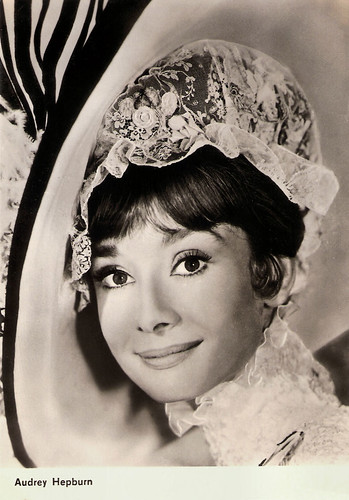
East-German postcard by VEB-Progress Film-Vertrieb, Berlin, no. 3028. Retail price: 0,20 MDM. Photo: Warner Bros. Publicity still for My Fair Lady (George Cukor, 1964).
Sources: Roger Ebert, Hal Erickson (AllMovie), Richard Gilliam (AllMovie), Ephraim Gadsby (IMDb), Dennis Littrell (IMDb), Wikipedia and IMDb.
My Fair Lady (George Cukor, 1964) is one of the all-time great film musicals, featuring classic songs by Alan Jay Lerner and Frederick Loewe and the wonderful costumes by Cecil Beaton. The film won eight Oscars, including Best Picture, Best Director and Best Actor for Rex Harrison in his legendary performance as misanthropic phonetics professor Henry Higgins. But Audrey Hepburn failed to be nominated for Best Actress. The Oscar was won by Julie Andrews for Mary Poppins, in what many observers saw as a backlash against Andrews' not being cast in the film after originating the role of Eliza on stage.

Spanish postcard by Oscarcolor. Photo: Audrey Hepburn in My Fair Lady (George Cukor, 1964).

East-German postcard by VEB-Progress Film-Vertrieb, Berlin, no. 2988. Retail price: 0,20 MDM. Photo: Warner Bros. Publicity still for My Fair Lady (George Cukor, 1964). Costume: Cecil Beaton.
The delusive dream of a man forming his own perfect woman
My Fair Lady was adapted by Alan Jay Lerner and Frederick Loewe as a stage musical from the the 1913 brilliant stage play Pygmalion by George Bernard Shaw about the delusive dream of a man forming his own perfect woman.
In Edwardian London, Professor Henry Higgins, a scholar of phonetics, believes that the accent and tone of one's voice determines a person's prospects in society. Outside Covent Garden on a rainy evening in 1912, he boasts to a new acquaintance, Colonel Hugh Pickering, himself an expert in phonetics, that he could teach any person to speak in a way that he could pass them off as a duke or duchess at an embassy ball.
Higgins selects as an example a young flower girl, Eliza Doolittle, who has a strong Cockney accent. Higgins tells Pickering that, within six months, he could transform Eliza into a proper lady, simply by teaching her proper English.
Eliza's ambition is to work in a flower shop, but her thick accent makes her unsuitable. Having come from India to meet Higgins, Pickering is invited to stay with the professor. The following morning, face and hands freshly scrubbed, Eliza shows up at Higgins' home, offering to pay him to teach her to be a lady. Pickering is intrigued and offers to cover all expenses, should the experiment be successful.
My Fair Lady became the longest-running Broadway musical with in the leads Rex Harrison as Henry and Julie Andrews as Eliza. With the same cast, the musical also became a huge success in London. Alan Jay Lerner and Frederick Loewe made a great musical score. Most of their songs would become standards over the years that delighted audiences all over the world.
However, when Hollywood producer Jack Warner decided to make a film version of the hit musical, he felt that Andrews, at the time unknown beyond Broadway, wasn't bankable. He replaced her with Audrey Hepburn, a wonderful film actress but not a real singer. Hepburn's singing was dubbed by Marni Nixon, who had dubbed Natalie Wood in West Side Story (1961). Supporting roles went to Stanley Holloway (as Eliza's father, dustman Afred P. Doolittle), Gladys Cooper (Henry's mother Mrs. Higgins), Wilfrid Hyde-White (Colonel Pickering) and Jeremy Brett as the young playboy Freddy.

Dutch postcard by Int. Filmpers, Amsterdam, no. 1306. Photo: Warner Bros. Rex Harrison and Audrey Hepburn in My Fair Lady (George Cukor, 1964).

Romanian postcard by Casa Filmului Acin, no. 261. Wilfrid Hyde-White and Audrey Hepburn in My Fair Lady (George Cukor, 1964).
How could Eliza be played by anyone else than Julie Andrews?
With a production budget of $17 million, My Fair Lady became the most expensive film shot in the United States up to that time. George Cukor created an elegant, colourful adaptation of the beloved stage musical and Rex Harrison did another winning performance. But how did Audrey Hepburn? The move to choose her over Julie Andrews had puzzled many in the theatrical world. How could Eliza be played by anyone else than Andrews?
Hepburn played the unschooled street urchin with a sweet, naive charm. Eliza goes through many forms of speech training, such as speaking with marbles in her mouth, enduring Higgins' harsh approach to teaching and his treatment of her personally. She makes little progress, but just as she, Higgins, and Pickering are about to give up, Eliza finally 'gets it'; she instantly begins to speak with an impeccable upper class accent. As the elegant and beautiful lady at the end of the film, Hepburn literally glows in the exquisite costumes designed for her by Cecil Beaton. She is a perfect match to Harrison's Higgins.
Ephraim Gadsby at IMDb: "The old furors over Audrey Hepburn seem silly in hindsight. Hepburn replaced Julie Andrews, a wonderful singer-actress who had created the role, not only on Broadway but in London. But Andrews was not a familiar face to movie-goers and no one knew if she'd hold an audience in the movies as in the live theaters. Too, Hepburn was an inspired choice, since her background probably would make Eliza Doolittle's transformation from flower-selling gutter-snipe into a lady of quality more believable (Hepburn's mother was a baroness)."
Richard Gilliam in his review at AllMovie: "Exquisitely produced by Warner Bros, it represents the zenith of the movie musical as an art form and as popular entertainment. Rex Harrison leads an impeccable cast, and, yes, that's Marni Nixon singing for Audrey Hepburn, but Hepburn is perfectly cast otherwise. The major star of the film is perhaps set designer/costume designer Cecil Beaton, whose visual contributions immediately impacted European and U.S. fashion trends."
In 1998, the American Film Institute named My Fair Lady (1964) the 91st greatest American film of all time. Critic Roger Ebert put the film on his 'Great Movies' list: "My Fair Lady is the best and most unlikely of musicals, during which I cannot decide if I am happier when the characters are talking or when they are singing. The songs are literate and beloved; some romantic, some comic, some nonsense, some surprisingly philosophical, every single one wonderful."

East-German postcard by VEB-Progress Film-Vertrieb, Berlin, no. 2989. Retail price: 0,20 MDM. Photo: Warner Bros. Publicity still for My Fair Lady (George Cukor, 1964) with Audrey Hepburn, Jeremy Brett and Rex Harrison.

East-German postcard by VEB-Progress Film-Vertrieb, Berlin, no. 3028. Retail price: 0,20 MDM. Photo: Warner Bros. Publicity still for My Fair Lady (George Cukor, 1964).
Sources: Roger Ebert, Hal Erickson (AllMovie), Richard Gilliam (AllMovie), Ephraim Gadsby (IMDb), Dennis Littrell (IMDb), Wikipedia and IMDb.
No comments:
Post a Comment